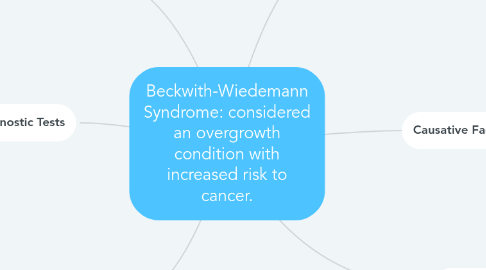Beckwith-Wiedemann Syndrome: considered an overgrowth condition with increased risk to cancer.
by Tony Ngo

1. Risk Factors
1.1. Usually occurs sporadically, but familial transmission occurs in approximately 15 percent of cases
2. Diagnostic Tests
2.1. Methylation-sensitive multiplex ligation probe analysis (MS-MLPA)
2.2. Karyotype analysis
2.3. chorionic villus sampling (CVS)
2.4. amniocentesis
3. Common findings
3.1. Increased height and weight at birth
3.2. Hypoglycemia at birth
3.3. Enlarged tongue
3.4. Creases on ear lobes
3.5. Visceromegaly
3.6. Greater risk for Wilm's tumor and hepatoblastoma
4. Treatments
4.1. No known treatment
4.2. Affected individuals live normal life span usually
4.3. As individuals are at a greater risk for tumors, regular and early screenings are important
4.4. Presentation is different and treatment includes treatment of manifestations of symptoms and complications
5. Pathophysiological Etiology
5.1. Linked to imprinting of chromosome 11
5.2. Usually related to receiving two copies of a chromosome from the father and zero from the mother.
5.3. These genes are found on deferentially methylated regions (DMRS). The gene that codes insulin-like growth factor 2 (IGF2) is active on the paternally transmitted chromosome. As a result of imprinting individuals receive 2 active copies from the father, doubling the amount of IGF2. This leads to fetal overgrowth related to excess gene expression.
6. Causative Factors
6.1. Caused by impriting.
6.2. Imprinting is known as gene silencing. It is when genes are predictably silenced either from the egg or sperm and as a result receive two copies of a single gene from one parent.


